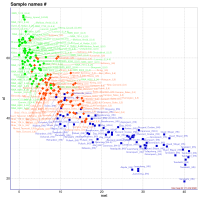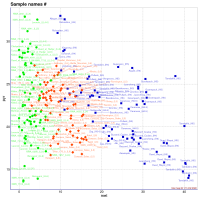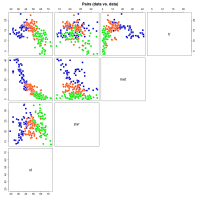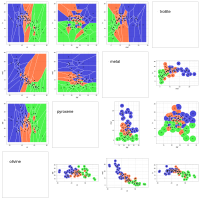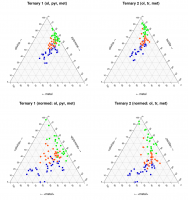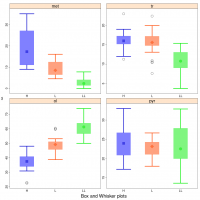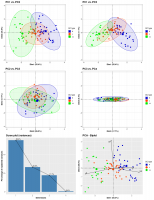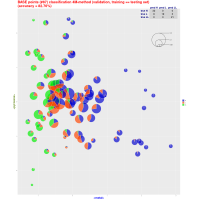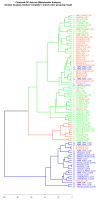(Unless otherwise stated, the copyright of the materials included belong to Jan Woreczko & Wadi.)
Szablon:Woźniak (2019, MaPS)
Z Wiki.Meteoritica.pl
m |
m (→Ilustracje) |
||
| (Nie pokazano 12 wersji pomiędzy niniejszymi.) | |||
| Linia 1: | Linia 1: | ||
| - | Woźniak Marek, Gałązka‐Friedman Jolanta, Duda Przemysław, Jakubowska Martyna, Rzepecka Patrycja, Karwowski Łukasz, (2019), '''Application of Mössbauer spectroscopy, multidimensional discriminant analysis, and Mahalanobis distance for classification of equilibrated ordinary chondrites''', ''Meteoritics & Planetary Science'', vol. 54(8), 2019, s. 1828-1839.<ref>'''Abstract:''' Mössbauer spectra of equilibrated ordinary chondrites consist of two doublets due to paramagnetic iron present in olivines and pyroxenes and two sextets due to magnetically ordered iron present in metallic phases and troilite. The spectral areas of the different mineralogical phases found by Mössbauer spectroscopy in meteorites are proportional to the number of iron atoms in this mineralogical phase. This property of Mössbauer spectra can be the basis for constructing a method for the classification of ordinary chondrites. This idea was first explored at the Mössbauer Laboratory in Kanpur. This group suggested a qualitative method based on 2‐dimensional plots of Mössbauer spectral areas and thus classified properly some meteorites. We constructed a quantitative method using [https://en.wikipedia.org/wiki/Mössbauer_spectroscopy '''M'''össbauer spectral areas], [https://pl.wikipedia.org/wiki/Analiza_dyskryminacyjna '''m'''ultidimensional discriminant analysis], and [https://pl.wikipedia.org/wiki/Odległość_Mahalanobisa '''M'''ahalanobis distance] ('''4M method''') to determine the probability of a [https://en.wikipedia.org/wiki/Ordinary_chondrite '''m'''eteorite] to be of type H, L, or LL. Based on 59 Mössbauer spectra, we calculated by the 4M method, '''S<sub>cluster</sub>''', the ''level of similarity'' of the {{Link-MBD|code=34019|name=Goronyo}} meteorite to the clusters. On the plot of ferrosilite versus fayalite, the point representing Goronyo is located on the border between H and L areas. Calculated by the 4M method, the meteorite Goronyo is 32% similar to type H, 75% to type L, and 11% to type LL. Additional mineralogical analyses suggested that the Goronyo meteorite would be classified as type L, although it was originally reported as type H in the Meteoritical Bulletin Database. | + | Woźniak Marek, Gałązka‐Friedman Jolanta, Duda Przemysław, Jakubowska Martyna, Rzepecka Patrycja, Karwowski Łukasz, (2019), '''Application of Mössbauer spectroscopy, multidimensional discriminant analysis, and Mahalanobis distance for classification of equilibrated ordinary chondrites''', ''Meteoritics & Planetary Science'', vol. 54(8), 2019, s. 1828-1839 ({{!abs-ilink|:Szablon:Woźniak (2019, MaPS)}}).<ref>'''Abstract:''' Mössbauer spectra of equilibrated ordinary chondrites consist of two doublets due to paramagnetic iron present in olivines and pyroxenes and two sextets due to magnetically ordered iron present in metallic phases and troilite. The spectral areas of the different mineralogical phases found by Mössbauer spectroscopy in meteorites are proportional to the number of iron atoms in this mineralogical phase. This property of Mössbauer spectra can be the basis for constructing a method for the classification of ordinary chondrites. This idea was first explored at the Mössbauer Laboratory in Kanpur. This group suggested a qualitative method based on 2‐dimensional plots of Mössbauer spectral areas and thus classified properly some meteorites. We constructed a quantitative method using [https://en.wikipedia.org/wiki/Mössbauer_spectroscopy '''M'''össbauer spectral areas], [https://pl.wikipedia.org/wiki/Analiza_dyskryminacyjna '''m'''ultidimensional discriminant analysis], and [https://pl.wikipedia.org/wiki/Odległość_Mahalanobisa '''M'''ahalanobis distance] ('''4M method''') to determine the probability of a [https://en.wikipedia.org/wiki/Ordinary_chondrite '''m'''eteorite] to be of type H, L, or LL. Based on 59 Mössbauer spectra, we calculated by the 4M method, '''S<sub>cluster</sub>''', the ''level of similarity'' of the {{Link-MBD|code=34019|name=Goronyo}} meteorite to the clusters. On the plot of ferrosilite versus fayalite, the point representing Goronyo is located on the border between H and L areas. Calculated by the 4M method, the meteorite Goronyo is 32% similar to type H, 75% to type L, and 11% to type LL. Additional mineralogical analyses suggested that the Goronyo meteorite would be classified as type L, although it was originally reported as type H in the Meteoritical Bulletin Database;<br />patrz → [[Acta Soc. Metheor. Polon./Artykuły|Woźniak et al. (2020, ASMP)]] oraz [[Hyperfine Interactions/Artykuły|artykuły w ''Hyperfine Interactions'']]; więcej → woreczko.pl – [http://www.woreczko.pl/meteorites/features/glossary-4M-method.htm Metoda 4M (''4M method'')] {{SeparatorBull}} [http://4m.woreczko.pl/4mmlist.php Metoda 4M – formularz]</ref> Plik {{!doi|10.1111/maps.13314}}.<noinclude> |
| + | |||
| + | |||
| + | ---- | ||
| + | === Ilustracje === | ||
| + | |||
| + | Więcej → woreczko.pl – [http://www.woreczko.pl/meteorites/features/4M-method/4M-BASE-v2n_images.htm Metoda 4M – 4M-BASE-v2n], [http://www.woreczko.pl/meteorites/features/4M-method/4M-BASE-vmax_images.htm 4M-BASE-vmax].<br /> | ||
| + | (Chondryty zwyczajne typu H (<font color="#0000CC">■</font>), L (<font color="#FF0000">♦</font>), LL (<font color="#00FF00">●</font>). Wykresy sporządzony w pakiecie statystycznym R) | ||
| + | |||
| + | <gallery caption="" widths="200px" heights="200px" perrow="3"> | ||
| + | File:4M-BASE_2D_met-ol-names.png|Oliwin ''vs.'' metal (4M-BASE-vmax) | ||
| + | File:4M-BASE_2D_met-pyr-names.png|Piroksen ''vs.'' metal (4M-BASE-vmax) | ||
| + | File:4M-BASE_pairs.png|Wykres ''wszyscy-ze-wszystkimi'' (''pairs'') <br />(4M-BASE-vmax) | ||
| + | File:4M-BASE_voronoi001.png|''Voronoi diagrams''. Wykres zainspirowany opisywanymi w literaturze pomysłami prostego podziału przestrzeni cech na rozłączne obszary zawierające meteoryty tylko jednego typu | ||
| + | File:4M-BASE_ternary.png|Wykres trójkątny (''ternary plot'') na którym doskonale widać potencjał dyskryminacyjny parametrów mössbauerowskich | ||
| + | File:4M-BASE_box.png|Wykresy ''box and whisker'' - wykresy pudełkowe i wąsy podsumowują rozkład danego parametru; pokazują ramkę dla 1 i 3 kwartyla, linię w ramce (?!) dla 50. centyla (medianę) i kropkę dla średniej. Wąsy pokazują 1,5 × wysokość prostokąta (zwanego przedziałem między kwartylami, ''interquartile range'', IQR), co wskazuje oczekiwany zakres danych, a wszelkie dane poza tymi wąsami są uznawane za wartości odstające i oznaczone kropką | ||
| + | File:4M-BASE_PCA-norm001.png|Analiza głównych składowych (''Principal Component Analysis, PCA'') | ||
| + | File:4M-BASE_pie.png|Weryfikacja, zbiór testowy ≡ zbiór uczący | ||
| + | File:4M-BASE_cluster_complete.png|Wykres aglomeracyjny (analiza skupień, ''cluster analysis'') na którym widać potencjał dyskryminacyjny parametrów mössbauerowskich | ||
| + | </gallery> | ||
| + | |||
{{Przypisy|ncol=1}} | {{Przypisy|ncol=1}} | ||
| Linia 5: | Linia 25: | ||
* woreczko.pl – [http://www.woreczko.pl/meteorites/features/glossary-4M-method.htm Metoda 4M (''4M method'')]. Zastosowanie spektroskopii Mössbauera, wielowymiarowej analizy dyskryminacyjnej i odległości Mahalanobisa do klasyfikacji zrównoważonych chondrytów zwyczajnych (''Application of Mössbauer spectroscopy, multidimensional discriminant analysis, and Mahalanobis distance for classification of equilibrated ordinary chondrites'') | * woreczko.pl – [http://www.woreczko.pl/meteorites/features/glossary-4M-method.htm Metoda 4M (''4M method'')]. Zastosowanie spektroskopii Mössbauera, wielowymiarowej analizy dyskryminacyjnej i odległości Mahalanobisa do klasyfikacji zrównoważonych chondrytów zwyczajnych (''Application of Mössbauer spectroscopy, multidimensional discriminant analysis, and Mahalanobis distance for classification of equilibrated ordinary chondrites'') | ||
| + | |||
| + | * Wikipedia – [https://pl.wikipedia.org/wiki/Analiza_głównych_składowych Analiza głównych składowych] {{SeparatorBull}} [https://pl.wikipedia.org/wiki/Analiza_skupień Analiza skupień] {{SeparatorBull}} [https://pl.wikipedia.org/wiki/Diagram_Woronoja Diagram Woronoja] | ||
| + | * Wikipedia (EN) – [https://en.wikipedia.org/wiki/Ternary_plot Ternary plot] | ||
[[Category:Bibliografia (szablony)|{{PAGENAME}}]] | [[Category:Bibliografia (szablony)|{{PAGENAME}}]] | ||
</noinclude> | </noinclude> | ||
Aktualna wersja na dzień 17:27, 17 cze 2023
Woźniak Marek, Gałązka‐Friedman Jolanta, Duda Przemysław, Jakubowska Martyna, Rzepecka Patrycja, Karwowski Łukasz, (2019), Application of Mössbauer spectroscopy, multidimensional discriminant analysis, and Mahalanobis distance for classification of equilibrated ordinary chondrites, Meteoritics & Planetary Science, vol. 54(8), 2019, s. 1828-1839 (abstrakt).[1] Plik doi.
Ilustracje
Więcej → woreczko.pl – Metoda 4M – 4M-BASE-v2n, 4M-BASE-vmax.
(Chondryty zwyczajne typu H (■), L (♦), LL (●). Wykresy sporządzony w pakiecie statystycznym R)
Wykresy box and whisker - wykresy pudełkowe i wąsy podsumowują rozkład danego parametru; pokazują ramkę dla 1 i 3 kwartyla, linię w ramce (?!) dla 50. centyla (medianę) i kropkę dla średniej. Wąsy pokazują 1,5 × wysokość prostokąta (zwanego przedziałem między kwartylami, interquartile range, IQR), co wskazuje oczekiwany zakres danych, a wszelkie dane poza tymi wąsami są uznawane za wartości odstające i oznaczone kropką |
||
Przypisy
Linki zewnętrzne
- woreczko.pl – Metoda 4M (4M method). Zastosowanie spektroskopii Mössbauera, wielowymiarowej analizy dyskryminacyjnej i odległości Mahalanobisa do klasyfikacji zrównoważonych chondrytów zwyczajnych (Application of Mössbauer spectroscopy, multidimensional discriminant analysis, and Mahalanobis distance for classification of equilibrated ordinary chondrites)
- Wikipedia – Analiza głównych składowych ● Analiza skupień ● Diagram Woronoja
- Wikipedia (EN) – Ternary plot
